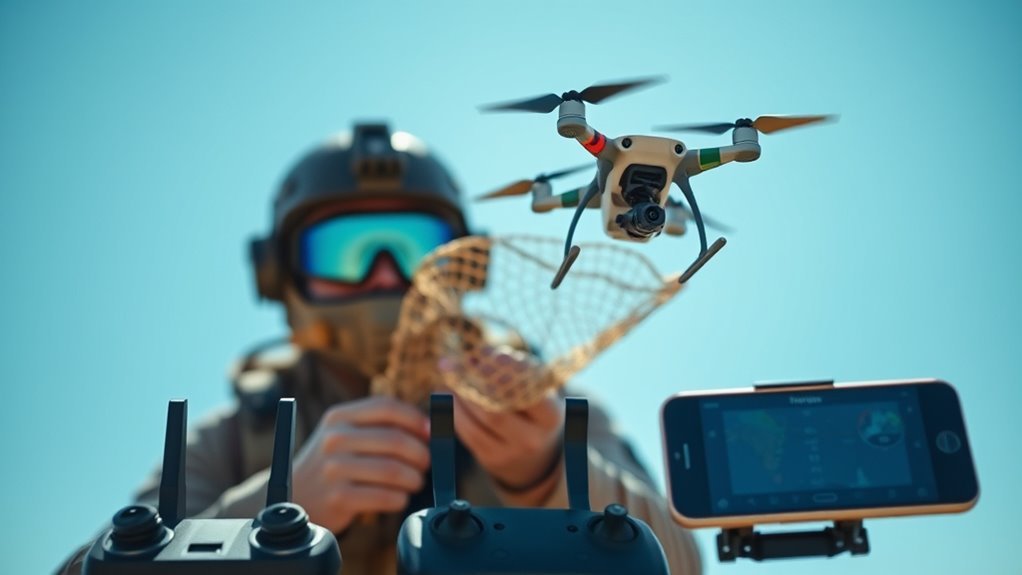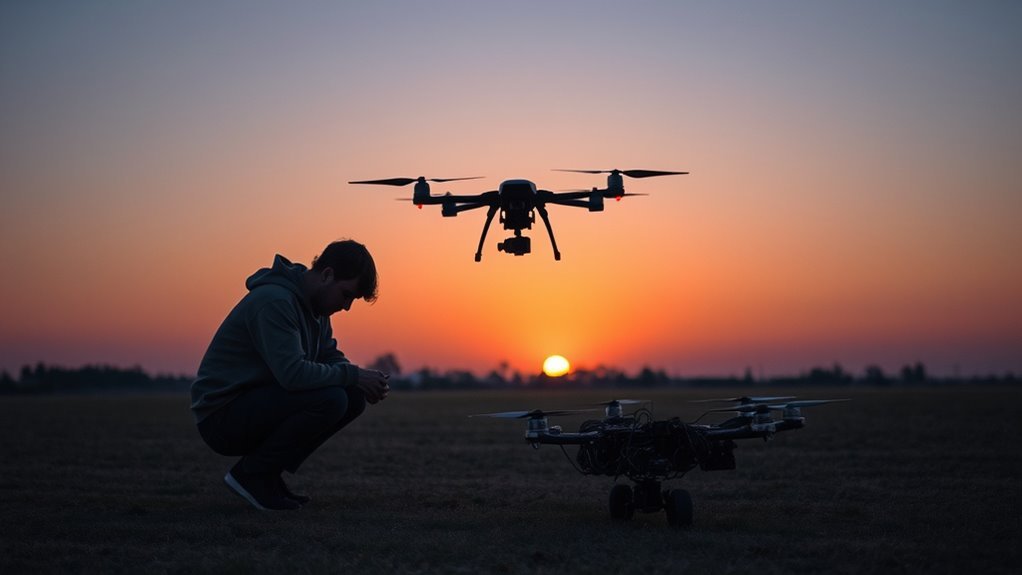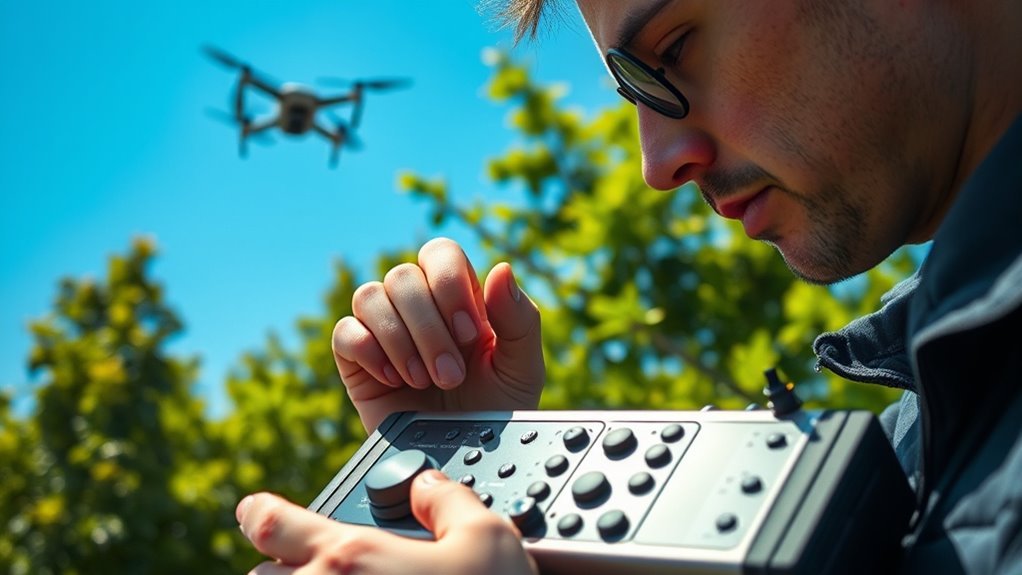To bring down unwanted drones, first understand the legal implications to avoid liability. Assess the drone type to choose appropriate methods—consider non-destructive techniques like signal jamming or laser disruption. If necessary, use physical methods such as nets or projectile devices, while being mindful of your surroundings. Always document the situation and report it to authorities when needed. For a thorough approach to protect your privacy and space, more strategies are essential for effective defense.
Understanding the Legal Implications of Drone Interference

While you may feel compelled to take action against drones infringing on your privacy or safety, it is important to understand the legal framework governing drone interference. Drone regulations vary greatly by jurisdiction, and violating these laws can lead to severe legal consequences. For instance, using physical force against a drone could result in criminal charges or civil liability. Additionally, federal regulations, such as those from the FAA, strictly govern airspace and unmanned aerial vehicles. Before you consider any countermeasures, it’s significant to research your local laws and federal statutes to guarantee compliance. Ignorance of these regulations won’t protect you from potential prosecution; therefore, understanding the legal landscape is critical in safeguarding your rights while managing drone interference effectively. Furthermore, recognizing that drones are classified as aircraft under federal law is essential to ensure you do not engage in unlawful actions.
Assessing the Situation: Identifying the Type of Drone

After familiarizing yourself with the legal implications of drone interference, the next step is to accurately identify the type of drone you’re dealing with. Begin by examining the drone classification—recreational, commercial, or military. Each category has distinctive identifying features. For instance, recreational drones are typically smaller and may have brightly colored designs, while commercial drones often feature enhanced cameras or sensors for specific tasks. Military drones tend to be larger, with stealth capabilities and advanced technology. Look for visual cues like size, shape, and noise level to assist in your identification process. Understanding these characteristics not only informs your approach but guarantees you’re prepared for potential responses based on the type of drone in your vicinity.
Non-Destructive Methods to Disable Drones

When considering non-destructive methods to disable drones, signal jamming techniques and laser disruption devices emerge as viable options. Signal jamming targets the communication between the drone and its operator, rendering it unresponsive without causing physical damage. Alternatively, laser disruption devices can interfere with the drone’s sensors, effectively neutralizing its capabilities while preserving the unit’s integrity. However, it is crucial to note that federal laws may restrict the use of signal jamming devices in many jurisdictions.
Signal Jamming Techniques
As the use of drones proliferates across various sectors, the need for effective countermeasures becomes increasingly critical, particularly in environments where privacy and security are at stake. Signal jamming techniques offer a non-destructive approach to disable these devices by creating signal interference. Here’s what you need to understand about jamming devices:
- Frequency Range: Identify the specific frequency your target drone uses for communication.
- Power Output: Use jamming devices with sufficient power to disrupt signals effectively.
- Directional Jamming: Aim your device to focus interference on specific drone frequencies.
- Legal Considerations: Be aware of local laws regarding the use of jamming technology.
These methods can help maintain your privacy and protect your space from unwanted surveillance.
Laser Disruption Devices
Although many counter-drone methods focus on signal disruption, laser disruption devices present a promising non-destructive alternative for disabling drones. These devices utilize focused laser beams to interfere with a drone’s sensors, rendering it inoperable without physical damage.
| Feature | Description | Importance |
|---|---|---|
| Laser Safety | Adheres to safety standards | Protects operators and bystanders |
| Device Effectiveness | High precision targeting | Efficiently neutralizes threats |
| Range | Varies by model | Determines operational capability |
| Power Source | Battery or AC powered | Impacts portability |
| Deployment Time | Minimal setup required | Quick response to threats |
Using Technology: Signal Jammers and Other Devices
When considering methods to disable drones, understanding signal jammers is vital; they disrupt communication between the drone and its operator. Additionally, exploring alternative disruption devices can provide effective solutions tailored to specific scenarios. However, it is important to weigh the legal considerations associated with using these technologies to guarantee compliance with regulations.
Signal Jammer Basics
To effectively disrupt a drone’s operations, understanding the fundamentals of signal jammers is essential. Signal jammers work by emitting radio waves that interfere with specific signal types used for drone communication. Here are key aspects of jammer functionality:
- Frequency Range: Different drones operate on varying frequencies; know which ones to target.
- Power Output: Higher output jammers can cover a larger area but may require careful regulation.
- Directional vs. Omnidirectional: Decide if you need a focused beam or wider coverage.
- Legal Considerations: Familiarize yourself with local laws regarding signal jamming; unauthorized use can lead to severe penalties.
Utilizing this knowledge enables you to effectively engage with drone threats while maneuvering through the legal landscape.
Alternative Disruption Devices
In the domain of drone disruption, alternative devices complement signal jammers and provide unique methods for neutralizing aerial threats. You might consider using kinetic interceptors, which physically disable drones by colliding with them. Another option is the use of directed energy weapons, which can disrupt drone electronics through focused microwave or laser technology. These alternative disruption devices fall under the broader category of electronic warfare, designed to target the communication and navigation systems of drones. By understanding these technologies, you can effectively evaluate their potential for protecting your airspace. Always keep in mind that while these methods offer tactical advantages, they require careful consideration of operational environments and limitations to maximize effectiveness.
Legal Considerations Explained
Although the effectiveness of signal jammers and other disruption devices might seem appealing for neutralizing drones, their legal implications can be quite complex. Before considering such actions, it’s essential to understand the drone regulations in your area and the potential legal ramifications you might face. Here’s what you should keep in mind:
- Federal Law: The Federal Communications Commission (FCC) strictly prohibits jamming devices.
- State Regulations: Local laws may vary widely, affecting your ability to deploy disruption technology.
- Liability Issues: You could be held liable for damages caused to third-party property or privacy violations.
- Enforcement Actions: Authorities might take legal action against you for unauthorized use of interference technology.
Always consult legal experts before starting on drone countermeasures.
Physical Techniques for Bringing Down Drones
Engaging physical techniques for bringing down drones require a thorough understanding of their operational mechanics and vulnerabilities. To effectively execute a drone capture, consider employing physical barriers such as nets or specialized drone-catching devices. These create a direct impediment to the drone’s flight path, allowing for safe retrieval. Additionally, using a slingshot or similar projectile can disrupt the drone’s stability, targeting its propellers or sensors to cause malfunction. Be aware of wind conditions and the drone’s altitude for best precision. Always aim to minimize risk to yourself and bystanders. Remember, understanding your environment and the drone’s technology can enhance your success in bringing it down without resorting to more dangerous methods.
Reporting Unwanted Drones to Authorities
When facing unwanted drones, especially in sensitive areas or during private events, reporting the issue to the appropriate authorities is a practical step. Familiarizing yourself with the proper reporting procedures can enhance drone enforcement effectiveness. Here’s what you should do:
- Document the incident: Note the time, location, and nature of the drone activity.
- Take photos or videos: Visual evidence can support your report.
- Contact local authorities: Reach out to law enforcement or aviation authorities responsible for drone regulations.
- File a formal complaint: Provide detailed information to assist in the investigation.
Preventative Measures to Protect Your Privacy and Space
To effectively safeguard your privacy and personal space from unwanted drone surveillance, implementing a series of strategic preventative measures is essential. Start by establishing designated privacy zones around your property, utilizing natural barriers like trees or fences to obstruct drone visibility. Invest in drone detection technologies, such as RF signal detectors, which alert you to nearby drone activity. Regularly monitor local airspace regulations and participate in community awareness initiatives to strengthen collective defenses. Consider using anti-drone devices that disrupt signals or create safe zones where drones are prohibited. By proactively addressing these concerns, you can considerably enhance your control over your space, ensuring your freedom remains intact from intrusive surveillance. Implementing these measures empowers you to reclaim your privacy.
Frequently Asked Questions
Can I Legally Own a Drone-Catching Device?
You can legally own a drone-catching device, but you must comply with drone regulations in your area. Always verify device legality aligns with local laws to avoid potential legal issues regarding its usage and operation.
What Should I Do if a Drone Crashes?
If a drone crashes, approach the crash site cautiously. Assess for safety hazards, then document the scene. Contact local authorities for drone recovery, ensuring you respect privacy and legalities regarding the device and its owner.
Are There Specific Drones That Are Harder to Disable?
Yes, certain drone technologies, especially those using advanced stabilization and communication systems, can be harder to disable. Effective disabling methods often require knowledge of these technologies to guarantee successful intervention without collateral damage.
How Can I Identify the Drone Operator?
To identify the drone operator, employ drone identification techniques and analyze operator behavior. Observe flight patterns, signal sources, and physical presence. A detailed examination of these factors can reveal crucial information about the operator’s intentions and location.
What Are the Risks of Using Signal Jammers?
Using signal jammers poses significant risks, including potential legal consequences for signal interference. You may inadvertently disrupt essential communications, leading to safety issues or regulatory penalties. It’s crucial to understand these threats before considering such actions.

